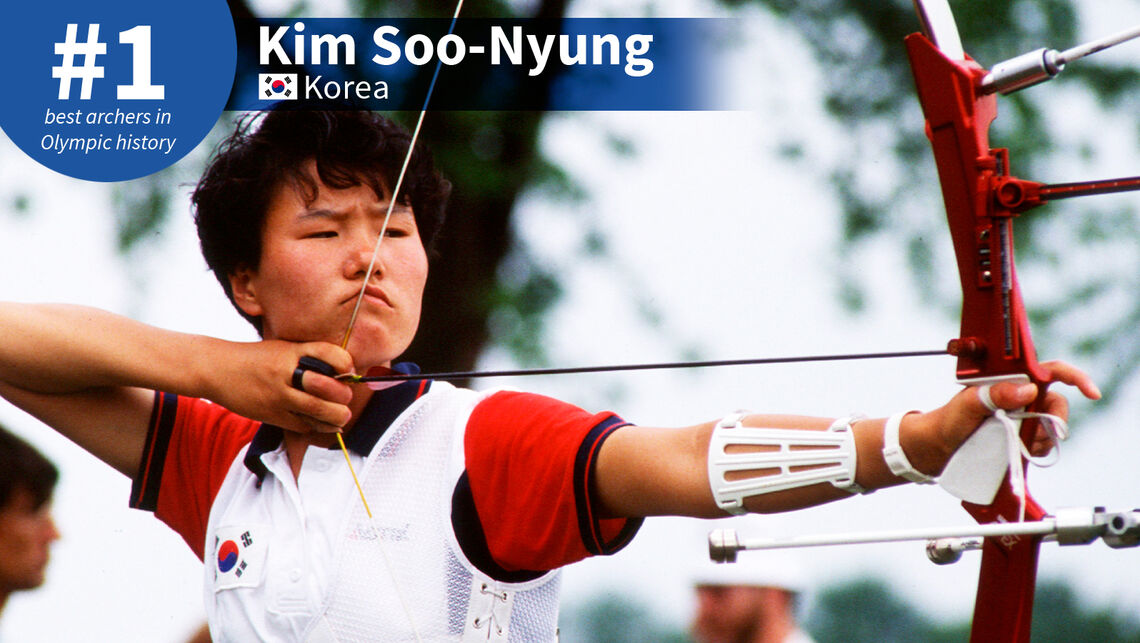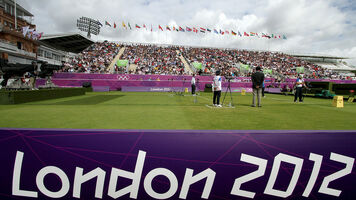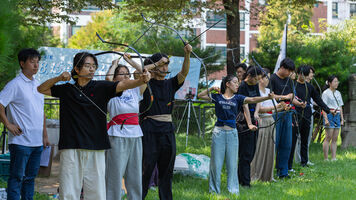Best Olympic Archers of All-Time: #1 Kim Soo-Nyung

Some pictures courtesy Yoshi Komatsu.
Each week in the lead up to the Rio 2016 Olympic Games, we’ll be revealing another athlete on our list of the top 15 Olympic archers of all time. This week, it’s…
#1: KIM SOO-NYUNG
NOC: Korea 
Born: 5 April 1971, Chungbeongbuk, South Korea 
Olympic caps: 3 (Seoul 1988, Barcelona 1992, Sydney 2000)
The Medals
 | Seoul 1988 Olympic Games |  |
 | Seoul 1988 Olympic Games |  |
 | Barcelona 1992 Olympic Games |  |
 | Barcelona 1992 Olympic Games |  |
 | Sydney 2000 Olympic Games |  |
 | Sydney 2000 Olympic Games |  |
The Reason
Over the last three decades, 17 Korean women have won Olympic gold medals in archery. Three of them have already appeared in this list, but one name stands above all the rest.
With four gold medals, a silver and a bronze, Kim Soo-Nyung is the supreme Olympic archer of the modern era – and with a remarkable comeback story thrown in.
In 1988, the Olympics were held in Seoul, Korea. The event was widely seen as a watershed in the history of the country, a key part of its transformation from a war-ravaged, poverty-stricken nation into an industrial powerhouse. Relations with its neighbour in the north were as complex as they are today, and – at one point – the IOC suggested that the NOC for DPR Korea host the archery, football and table tennis competitions north of the border, to help promote peace.
The star of the Korean team, Kim Soo-Nyung, had been shooting since she was nine years old.
“I moved school at that time, and a teacher recommended it. Archery was just an after-school event – I shot after studying. After a year, I participated in a regional competition, and I won individual silver,” she said.
“I kept in touch with the teacher, and years later I asked him: ‘Why did you recommend archery to me?’ He answered, ‘you are taller than the others and your arm length is quite long’,” she said.
From the of age 13, she put in an all-out effort into archery, apparently neglecting her middle school studies to do so. It paid off: Soo-Nyung made the national team at 16, when she set a world record at 30 metres and won individual gold at the international ‘COQ France’ event, a forerunner of the Archery World Cup.
The Korean Olympic recurve machine was already in place, taking two individual medals in Los Angeles, but was in full flow by Seoul. The unique format for the 1988 games involved archers shooting a ‘Grand FITA’ over four rounds at the Hwarang field, with the shortest distance shot first; the field was cut and the scores were reset after each round.

The three Korean women were always in the top five, but Kim improved her score every day.
“I could see the gold medal coming… On the last round I shot nine arrows at 30 metres and got a perfect 90 points, I felt more confident and got better and better. Once the target moved to 50 metres, I shot six of the first nine arrows in the 10,” she recalled. “I set-up again, and was on my game and so confident that again it just went 10-10-10…”
The last distance of the final was nine arrows at 70 metres.
“I can remember standing on the shooting line, target number one. There were too many photographers, maybe 30 or 50 people. They took too many pictures and were very noisy, with the film cameras at the time,” she said.
“I remember thinking: ‘You do your job and take a good picture of me. I will shoot bravely, like I did in practice, I’m going to think about my performance and what I’m doing, not yours’.”
Kim won the gold medal by 12 clear points with 344, ahead of teammates Wang Hee-Kyung and Yun Young-Sook in second and third, as the trio swept the podium for Korea. They were aged just 17, 18, and 17, respectively.
“I think other competitors did their best but my performance had really peaked in those months, that’s why there was a big difference between first and second,” said Kim.

The next day, all three returned to the team event, which followed a similar format, and ended with a similar, crushing result: The Korean women won gold by 30 points, with Indonesia second and the USA third.
Now a double gold medallist, Kim continued her world-dominating form, winning back-to-back World Archery Championships in 1989 and 1991. She had acquired the nickname ‘The Viper’ for her terrifying match performance.
“One of the coaches started calling me that. I thought it was a good nickname, because it made people think I was even stronger than I was!”
At one point, she held almost every outdoor record including all four of the 1440 Round distances (70, 60, 50 and 30 metres).
What made the difference? In Soo-Nyung’s own words: “For me, bow arm stability and shooting fast. A strong bow arm is the most important element of technique, as it is the part that can cause the most errors. Fast shooting gave me my best performances, but I think each archer must find the timing that works for them.”
“Consistent performance is the most important thing for archers. Most Olympic gold medalists perform consistently regardless of how they are feeling, and developing that consistency is a skill. Firstly, you have to learn what to do, then learn about yourself and your feelings, and finally deliver the performance,” she said.

In Barcelona in 1992, the now familiar Olympic head-to-head round was introduced to the individual competition. The final was between Kim and Cho Youn-Jeon, her teammate and an athlete who allegedly calmed her nerves before competitions by taking long walks through the cemetery at night.
Kim lost the gold to Cho by seven points.
“I was shooting badly that day, unfortunately. I could see the loss coming. You can see my face looking unhappy in the final. But I remember being satisfied with the last arrow, that was a 10 that was precisely aimed. I thought, if I can shoot a 10 for the last arrow I haven’t lost it completely,” Kim recalled.
In the team competition, the Korean women obliterated the ranking round world record with 4094 points combined. However, they had to survive a shoot-off against Sweden in the quarterfinals – with Kim drilling the crucial final 10 – before beating France and then China to take gold.
With a record three Olympic golds and a silver medal, Kim retired from the sport and began to raise a family.
“I didn’t pick up a bow for six years. I got married in 1994, my daughter was born in 1995, and my son in February 1999,” she said.
But that year, something changed. One of the Korean archery manufacturers wanted her to work with them: “I thought, if I had a chance to do something for archery, I’d really want to be an athlete again.”
“Ultimately, the decision to return was simple, but shooting itself was harder than I thought. I was wondering if there was any talent remaining, and I had to work a lot harder than when I was a teenager. But I participated in a national competition, and came around 10th so I felt there was potential.”

Just eight months of intense training later, once again she made the Olympic team, this time for Sydney 2000. The individual competition saw her old form returning, with her ability to handle the pressure key to several victories against younger opponents.
But in the semifinal she came up against teammate Yun Mi-Jin, 12 years younger and an archer who had learned many things from her. Just two arrows away from reaching the final, Kim shot an eight. Yun hit a 10 to take the lead and another ten to win the match, 107-105. Yun then beat Kim Nam-Soon for gold, with Soo-Nyung beating DPR Korea’s Choe Ok-Sil for bronze to, once again, sweep the podium for Korea.
The pupils had surpassed the master.
“We've learned from her confidence," Kim Nam-Soon said of having Kim Soo-Nyung as a teammate. "We learned just from watching her shoot with confidence.”
There were no mistakes in the team competition two days later, as the Korean women steamrollered every match by at least 12 points to become Olympic champions for the fourth time in a row. Soo-Nyung had a fourth gold and a bronze, and returned to retirement as the most decorated Korean archer of all time.
“We’re still yet to discover an archer who can exceed her,” said Yun Mi Jin, speaking in 2016. “When I was young, I wanted to go beyond her, setting her as my goal. If I didn’t have a rolemodel like Kim Soo-Nyung, I wouldn’t have been satisfied with what I accomplished in Sydney. It was truly an honour just being able to participate in the Olympics together.”
Kim Soo-Nyung’s career was defined by her miraculous comeback.
“It was a personal decision for me. Some Korean archers have made comebacks in other countries, like America and Japan. I think a Korean returning to the national team would now be very difficult, but you never know,” she said.
In 2011 Kim was named the female archer of the 20th century by World Archery.
She now concentrates on her family, with occasional forays into international coaching: “My daughter tried archery age 10, she shot a couple of times a week for a few months. She was not bad, but I told her archery is a very hard sport; if you shoot good it is fine, but if you shoot bad you might feel too much stress because of me.”
“She stopped soon after that.”
How does she feel when watching the current national team perform?
“I feel more tense watching than when I competed! I think I trust them but I worry about unexpected mistakes, because under the current rules every single arrow is important,” she said.
Soo-Nyung retains the passion for the sport that has defined her: “Archery gives you conviction. People need conviction all the time; to eat well, to do anything. I would say archery is the best sport for a great life.










